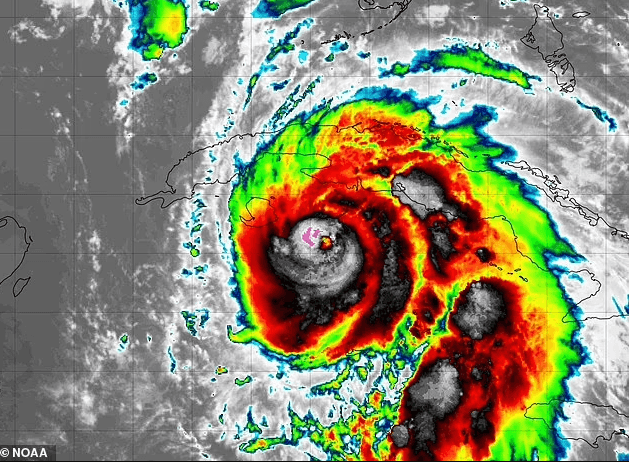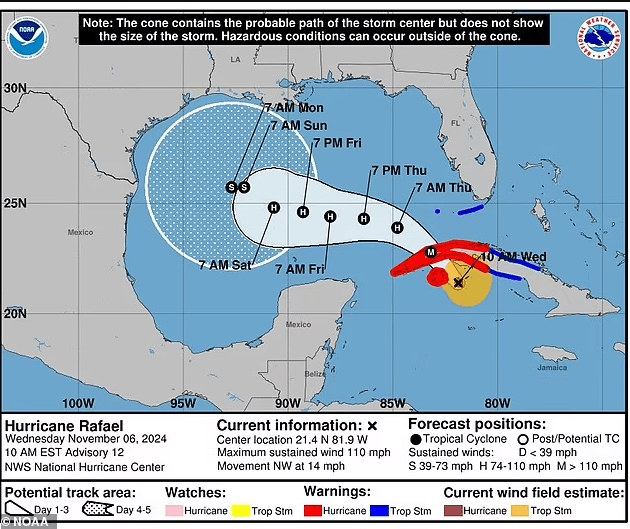Hurricane Rafael, now upgraded to a Category 2 storm, is barreling toward the U.S. with potential landfall ranging from the Texas coast to the Florida Panhandle. The storm is set to impact western Cuba and the Isle of Youth within the next 12 hours, bringing heavy rain, high winds, and dangerous storm surges to the region.
After passing over Cuba, Rafael is expected to intensify and enter the southeastern Gulf of Mexico tonight. The Florida Keys are already experiencing tropical storm conditions, prompting the National Hurricane Center (NHC) to issue a warning for residents to take precautions.
Americans along the Gulf Coast are advised to secure outdoor items due to the risk of strong winds and potential flooding. AccuWeather Senior Meteorologist Bill Deger emphasizes that even minor changes in Rafael’s strength or wind patterns could significantly alter its path, making its trajectory unpredictable.
The latest “spaghetti model,” named for the way projected paths resemble strands of pasta, shows four possible routes for Rafael. While its course remains uncertain, the model indicates the highest likelihood of landfall in Louisiana.

The NHC has issued a tropical storm warning for the Lower and Middle Florida Keys today as Hurricane Rafael approaches, bringing the possibility of up to three inches of rainfall and an elevated tornado risk across the region.
“Bands of rain with gusty winds are expected to impact this area through Wednesday night. A few tornadoes cannot be ruled out in the Keys and far southwestern Florida,” reports The Weather Channel.
The NHC notes that it is still too early to determine the exact impact Rafael will have on the U.S. Gulf Coast, but residents are urged to stay updated on forecast changes.
As of 10:00 a.m. ET, Rafael was located about 130 miles south-southeast of Havana, moving northwest at 14 mph with maximum sustained winds of 110 mph. A hurricane warning is in effect for the area, and residents are advised to prepare for “damaging hurricane-force winds, life-threatening storm surge, and destructive waves,” according to the latest advisory.
The NHC also reports that Rafael will bring heavy rain to parts of the Western Caribbean, including Jamaica, the Cayman Islands, and western Cuba, through early Thursday.
Upon entering the Gulf of Mexico, Rafael is expected to weaken due to less favorable conditions. “It is also possible that Rafael could be torn apart by strong upper-level winds and dissipate in the Gulf before reaching the U.S.,” said AccuWeather Senior Meteorologist Bill Deger.
An alternate prediction has Rafael tracking westward across the Gulf rather than northward toward the U.S., which would result in minimal impact to the U.S. Gulf Coast.

According to The Weather Channel, if Hurricane Rafael weakens but remains intact and shifts toward the northern Gulf Coast, it could intensify rainfall along a cold front this weekend into early next week.
Rafael marks the 17th named storm of the 2024 Atlantic hurricane season. While a direct impact on Florida is unlikely, tropical storm conditions may still strain local communities that are still recovering from hurricanes Helene and Milton, which struck within just two weeks of each other.
These recent hurricanes left widespread damage in Florida, resulting in an estimated 54 fatalities combined. The state’s Office of Insurance Regulation reports that insurance claims from Helene and Milton’s damage have now surpassed $4 billion.


As Hurricane Rafael approaches the U.S., the National Hurricane Center (NHC) is advising Floridians to keep a close eye on forecast updates.
Hurricanes in November are rare, as conditions for storm formation decline late in the Atlantic hurricane season. Since 1851, only 287 hurricanes have struck the U.S., with just four occurring in November, according to the National Oceanic and Atmospheric Administration (NOAA). The last November hurricane to hit was Nicole in 2022; prior to that, it was Katie in 1985.
Rafael, currently the strongest November hurricane to pass through the northwestern Caribbean since 2009, could intensify to a Category 3 before hitting land. This year, nine Atlantic storms, including Rafael, have rapidly intensified, fueled by unusually high ocean temperatures. NOAA notes that as climate change warms the oceans and atmosphere, rapid storm intensification is becoming more common.
